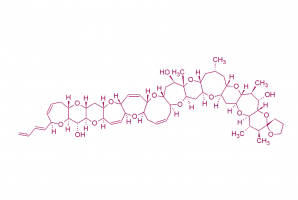PACKAGING AND PRICE
| Quantity |
Price(€) |
| 0.5 µg |
1 400.00 € |
| 1.0 µg |
2 800.00 € |
CTX4A is sent in suspension.
REFERENCES
[1] Satake M., Ishibashi Y., Legrand A.M., Yasumoto T. (1996). Isolation and structure of ciguatoxin-4A, a new ciguatoxin precursor, from cultures of dinoflagellate Gambierdiscus toxicus and parrotfish Scarus gibbus. Bioscience, biotechnology, and biochemistry, 60(12), 2103-2105. https://doi.org/10.1271/bbb.60.2103
[2] Chinain M., Darius T., Ung A., Cruchet P., Wang Z., Ponton D., Laurent, D., Pauillac S. (2010). Growth and toxin production in the ciguatera-causing dinoflagellate Gambierdiscus polynesiensis (Dinophyceae) in culture. Toxicon 56, 739-750. https://doi.org/10.1016/j.toxicon.2009.06.013
[3] Food and Agriculture Organization of the United Nations & World Health Organization. (2020). Report of the expert meeting on ciguatera poisoning: Rome, 19-23 November 2018. World Health Organization. https://apps.who.int/iris/handle/10665/332640
[4] Lombet A., Bidard J.N., Lazdunski, M. (1987). Ciguatoxin and brevetoxins share a common receptor site on the neuronal voltage‐dependent Na+ channel. FEBS letters, 219(2), 355-359. https://doi.org/10.1016/0014-5793(87)80252-1
Material Safety Data Sheet available on demand. Contact us.


